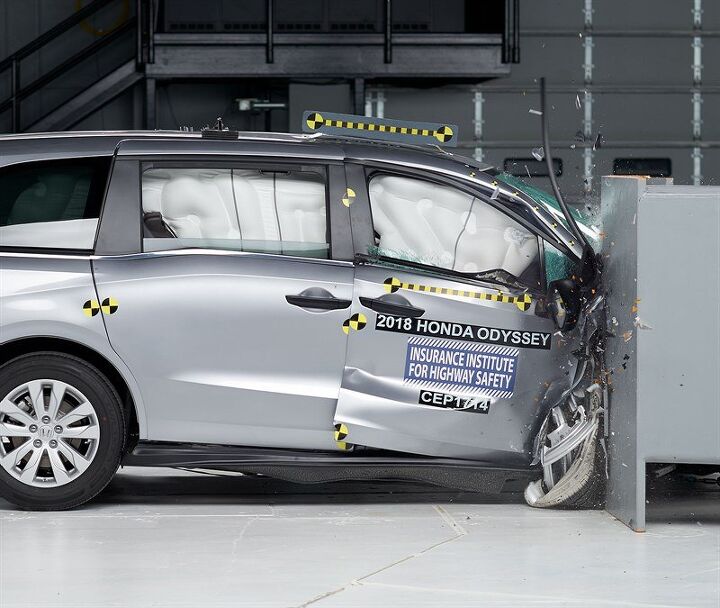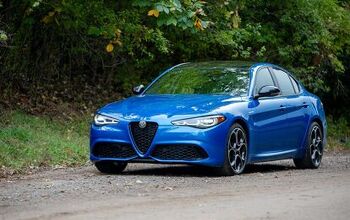Honda Odyssey Reigns Supreme in Latest Minivan Crash Test

You don’t need a family to own a minivan, it just helps avoid a series of awkward follow-up questions. However, regardless of whether you’re riding with your complete progeny or your only friend in the world, you probably hope your vehicle has your back in the event of an accident.
The Insurance Institute for Highway Safety’s small overlap crash test separated the wheat from the automotive chaff ever since its introduction in 2012. The test imagines what happens when the front corner of a vehicle collides with another vehicle or an stationary object, focusing an immense amount of energy on a small area of the automobile. It’s a worst-case scenario for the structural integrity of a model and makes for a great viewing experience, as it really does a number on the test car.
Despite fielding a rather pathetic number of vehicles, the minivan segment performed pretty well in the IIHS passenger-side small overlap front crash test on the whole. However, while no outright deathtraps revealed themselves, the group still saw some mixed results.
Honda’s Odyssey performed the best, receiving a good rating in every category but structural deformation — which was deemed average. It also managed the small overlap challenge like a champ on both the driver and passenger side of the vehicle. Overall, the IIHS declared the Odyssey worthy of the its Top Safety Pick award for 2018.
That was also true of the Chrysler Pacifica. However, the passenger-side small overlap test resulted in average levels of deformation. By no means abysmal, it placed the model a half step behind the Honda in overall crash protection. But we wouldn’t suggest it influence your shopping decisions more than a little, especially if you aren’t particularly fond of your spouse.
Unfortunately, Toyota’s Sienna proved ineligible for a Top Safety Pick award. Earlier tests showed the model lacking in structural integrity, as well. While the automaker has since made changes to improve driver-side protection, those alterations didn’t extend to the passenger side. This ultimately led to a vehicle with slightly better protection for the driver and rather poor protection for the front passenger.
Deformation was also an issue, and is plainly seen in the test footage. The Sienna saw as much as 20 inches of intrusion in the lower occupant compartment and more than 16 inches of intrusion at the dashboard. “The intruding structure crumpled around the test dummy’s legs. A real right front passenger would sustain possible injuries to the right hip and lower leg in a crash of this severity,” explained IIHS chief research officer David Zuby.
The silver lining is that the minivan segment performs well as a whole. Earlier tests of the Kia Sedona also resulted in Top Safety Pick honors, thanks to its structural integrity and superior headlamps. There was also no vehicle in the segment, save for the ancient Dodge Grand Caravan, without the option to add superior frontal crash prevention systems and adequate (or better) headlamps. Passenger restraints are also universally good, with the Pacifica’s Lower Anchors and Tethers for Children (LATCH) system proving a little more difficult to use than the rest of the group.
“In our latest passenger-side tests, we didn’t find any performance issues with safety belts or airbags like we did when we evaluated small and midsize SUVs earlier this year and midsize cars last year,” Zuby said. “Instead, we saw some structural deficiencies on the right side that still need addressing.”
The Kia Sedona and Dodge Grand Caravan weren’t subjected to the right-side test. But we’d imagine the Sedona performing rather well (and the Caravan to be exceptionally lacking) based upon previous driver-side overlap results. It should be noted that the Dodge managed a good showing in all other crash tests, despite receiving a poor rating overall. Blame that score on its crummy headlamps and complete lack of advanced driving aids, which the IIHS takes into serious consideration these days.
[Images: IIHS]

A staunch consumer advocate tracking industry trends and regulation. Before joining TTAC, Matt spent a decade working for marketing and research firms based in NYC. Clients included several of the world’s largest automakers, global tire brands, and aftermarket part suppliers. Dissatisfied with the corporate world and resentful of having to wear suits everyday, he pivoted to writing about cars. Since then, that man has become an ardent supporter of the right-to-repair movement, been interviewed on the auto industry by national radio broadcasts, driven more rental cars than anyone ever should, participated in amateur rallying events, and received the requisite minimum training as sanctioned by the SCCA. Handy with a wrench, Matt grew up surrounded by Detroit auto workers and managed to get a pizza delivery job before he was legally eligible. He later found himself driving box trucks through Manhattan, guaranteeing future sympathy for actual truckers. He continues to conduct research pertaining to the automotive sector as an independent contractor and has since moved back to his native Michigan, closer to where the cars are born. A contrarian, Matt claims to prefer understeer — stating that front and all-wheel drive vehicles cater best to his driving style.
More by Matt Posky
Latest Car Reviews
Read moreLatest Product Reviews
Read moreRecent Comments
- MaintenanceCosts Nobody here seems to acknowledge that there are multiple use cases for cars.Some people spend all their time driving all over the country and need every mile and minute of time savings. ICE cars are better for them right now.Some people only drive locally and fly when they travel. For them, there's probably a range number that works, and they don't really need more. For the uses for which we use our EV, that would be around 150 miles. The other thing about a low range requirement is it can make 120V charging viable. If you don't drive more than an average of about 40 miles/day, you can probably get enough electrons through a wall outlet. We spent over two years charging our Bolt only through 120V, while our house was getting rebuilt, and never had an issue.Those are extremes. There are all sorts of use cases in between, which probably represent the majority of drivers. For some users, what's needed is more range. But I think for most users, what's needed is better charging. Retrofit apartment garages like Tim's with 240V outlets at every spot. Install more L3 chargers in supermarket parking lots and alongside gas stations. Make chargers that work like Tesla Superchargers as ubiquitous as gas stations, and EV charging will not be an issue for most users.
- MaintenanceCosts I don't have an opinion on whether any one plant unionizing is the right answer, but the employees sure need to have the right to organize. Unions or the credible threat of unionization are the only thing, history has proven, that can keep employers honest. Without it, we've seen over and over, the employers have complete power over the workers and feel free to exploit the workers however they see fit. (And don't tell me "oh, the workers can just leave" - in an oligopolistic industry, working conditions quickly converge, and there's not another employer right around the corner.)
- Kjhkjlhkjhkljh kljhjkhjklhkjh [h3]Wake me up when it is a 1989 635Csi with a M88/3[/h3]
- BrandX "I can charge using the 240V outlets, sure, but it’s slow."No it's not. That's what all home chargers use - 240V.
- Jalop1991 does the odometer represent itself in an analog fashion? Will the numbers roll slowly and stop wherever, or do they just blink to the next number like any old boring modern car?

































Comments
Join the conversation
...Unfortunately, Toyota’s Sienna proved ineligible for a Top Safety Pick award. Earlier tests showed the model lacking in structural integrity, as well. While the automaker has since made changes to improve driver-side protection, those alterations didn’t extend to the passenger side. This ultimately led to a vehicle with slightly better protection for the driver and rather poor protection for the front passenger... The Toyota Sienna performed the worst of the trio of minivans. The safety cage collapsed on the passenger side in the test, resulting in a marginal rating. Earlier tests showed the Sienna was lacking in structural integrity and although Toyota made improvements to driver-side protection, those alterations clearly didn’t extend to the passenger side. I mean, I get you guys don't like to talk badly about Toyota, but your spin on the results in your paragraph smacks of Bertel days.
although I am still not convinced this test has any importance compared to the driver side...unless you are in England, but I simply cannot find the data. I have watched the video many times and both the Honda and Pacifica perform equally. There is no reason given for the acceptable rating on the build. Watch the video and you have to agree...where's the beef?